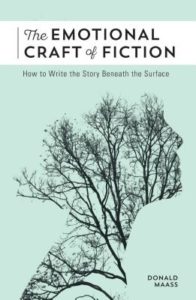craft review by Jesaka Long
Using symbols in young adult fiction can create emotional connections between reader, character, and story. The symbols—which frequently represent things like character’s relationship with a specific person, or a childhood relic signifying their resistance to growing up—typically have a meaning that does not change throughout the story. However, Donald Maass states in The Emotional Craft of Fiction, “anything meaningful to your characters can reverse, recur, or be deployed in ways that enhance its significance” (151). When the meaning of a symbol evolves during a story, it can heighten the stakes for both the character and the reader.
 But a symbol being “static” in no way diminishes its importance to the character or the story. In this post, I’ll examine the richness of a static symbol in Dumplin’ by Julie Murphy, and in Part 2 (look for the post next week), I’ll dig into the power of an evolving symbol in John Corey Whaley’s Highly Illogical Behavior.
But a symbol being “static” in no way diminishes its importance to the character or the story. In this post, I’ll examine the richness of a static symbol in Dumplin’ by Julie Murphy, and in Part 2 (look for the post next week), I’ll dig into the power of an evolving symbol in John Corey Whaley’s Highly Illogical Behavior.
In the novel Dumplin’, author Julie Murphy uses Dolly Parton’s music as a symbol of love and empowerment for main character Willow Dean. According to Maass, the “effectiveness of symbols begins with their setup. If there is no context . . . symbols can have no effect” (146). Murphy delivers this context with the first line of the novel: “All the best things in my life have started with a Dolly Parton song” as the very first line of the book (1). Willow also points out that her car, which she treasures, is connected to Parton: “Her name is Jolene and she is a 1998 cherry-red Pontiac Grand Prix, given to me by Lucy” (20).
As the story progresses, we learn Willow’s aunt, Lucy, introduced her to Dolly Parton—and that is where the best things in Willow’s life really started. However, Lucy died six months before Dumplin’ starts and, when we meet Willow, she’s grieving for her beloved aunt. When Willow’s mother cleans out Lucy’s room, Willow finds a box of cassette tapes—all Dolly Parton—and reveals, “It wasn’t just the look of Dolly that drew us in. It was the attitude that came with knowing how ridiculous people thought she looked, but never changing a thing because she felt good about herself. To us, she is . . . invincible” (26). As the story progresses, the symbol accrues more meaning, but that meaning stays consistent as the novel continues.
Much of Dumplin’ focuses on the Miss Teen Blue Bonnet pageant, which Willow’s mother won as a teenager and now oversees. Willow competes in the pageant, which is a huge source of tension for her and mother. Unlike her mother, who still fits into her Miss Teen Blue Bonnet dress from decades ago, Willow is fat—and she claims the word as her own; it is not an insult. As the conflict between mother and daughter plays out, Willow turns again and again to the comfort, love, and strength she feels when she listens to Parton’s songs like “Jolene.”
 The story crescendos into its climax when Willow dresses up as Dolly and performs a lip sync of “Jolene,” during which she closes her eyes and sees “every moment I’ve heard this song” (363). Her memories include “Driving down the highway with my mom, Lucy, and Gram. The windows down. All four of us dragging our hands through the wind” (363). And, of course, it includes Lucy’s funeral. Although the lip sync disqualifies Willow from the pageant, the moment for her on the stage, channeling Dolly, is a triumph: she, too, is invincible. It’s a beautiful, earned, crowd-pleasing moment, destined to find itself on the list of one of “the best things” in Willow’s life.
The story crescendos into its climax when Willow dresses up as Dolly and performs a lip sync of “Jolene,” during which she closes her eyes and sees “every moment I’ve heard this song” (363). Her memories include “Driving down the highway with my mom, Lucy, and Gram. The windows down. All four of us dragging our hands through the wind” (363). And, of course, it includes Lucy’s funeral. Although the lip sync disqualifies Willow from the pageant, the moment for her on the stage, channeling Dolly, is a triumph: she, too, is invincible. It’s a beautiful, earned, crowd-pleasing moment, destined to find itself on the list of one of “the best things” in Willow’s life.
As fundamental as Dolly’s music is in Dumplin’, its role as a symbol of the strength and love Lucy so freely gave to Willow does not change. It’s a constant that guides—but does not impact the stakes of—Willow’s journey to claim the spotlight in her own story.
Actions:
- Identify something meaningful to your character, such as an object or song
- Note what this symbol means to your character at its first mention in your story
- How can the symbol show up later in your story to guide your character through decisions she must make?
Watch for next week’s post on the power of an evolving symbol in John Corey Whaley’s Highly Illogical Behavior.
Jesaka Long writes young adult novels and short stories. She’s also a freelance editor and copywriter. Jesaka teaches creative non-fiction, screenwriting, and fiction classes to students in grades 6-12 through the non-profit literary organization Lighthouse Writers Workshop. One of her biggest loves is the Lighthouse Young Authors Collective, a group of twelve high school writers that she’s been leading for the last four years. Jesaka lives in Denver with her partner Kristi and their extraordinarily spoiled dog Effie P.


I have been wanting to read this book. I’m going to see if I can pick it up at the library on my way home. Excellent post!
Thanks so much, Becky! I’d love to know what you think of Dumplin’.